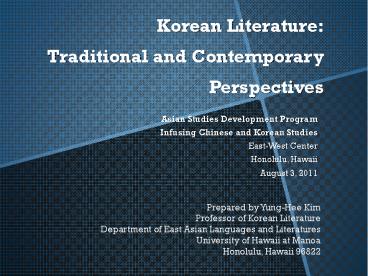Korean Literature: Traditional and Contemporary Perspectives - PowerPoint PPT Presentation
Title:
Korean Literature: Traditional and Contemporary Perspectives
Description:
Title: Slide 1 Author: Michael E. Macmillan Last modified by: Michael E. Macmillan Created Date: 9/13/2004 9:38:35 PM Document presentation format – PowerPoint PPT presentation
Number of Views:602
Avg rating:3.0/5.0
Title: Korean Literature: Traditional and Contemporary Perspectives
1
Korean LiteratureTraditional and Contemporary
Perspectives
- Asian Studies Development Program
- Infusing Chinese and Korean Studies
- East-West Center
- Honolulu, Hawaii
- August 3, 2011
Prepared by Yung-Hee Kim Professor of Korean
Literature Department of East Asian Languages and
Literatures University of Hawaii at
Manoa Honolulu, Hawaii 96822
2
Chronology of Korean History
1. Old Choson Kingdom (2333 B.C.-?) Founder
Tangun Capital Pyongyang 2. Three-Kingdom
Period 1) Koguryo (37 B.C. - 668 A.D.) Founder
King Tongmyong Capital Pyongyang 2) Paekche
(18 B.C. - 663 A.D.) Founder King Onjo Capital
Puyo 3) Silla (57 B.C. - 668 A.D.) Founder Pak
Hyokkose Capital Kyongju
3
Chronology of Korean History
3. Unified Silla Kingdom (668 A.D.935 A.D.) 4.
Koryo Dynasty (9181392) Founder Wang Kon (King
Taejo) Capital Songdo (Kaesong) 5. Choson (or
Yi) Dynasty (13921910) Founder Yi Song-gye
(King Taejo) Capital Hansong (Seoul) 6.
Japanese Colonial Rule (19101945) 7. Republic
of Korea (1948 ) First President Syngman
Rhee Capital Seoul
4
Pre-modern Korean Literary Traditions
1. Foundation Myth Tangun, the sacred,
politico-cultural hero Bear woman, tiger, and
taboos Rite of passage Folk medicine Justification
of national sovereignty
5
Pre-modern Korean Literary Traditions
2. Classical Choson Poetry Sijo Prosody,
structure, and artistry ??? ? ??? ??? ?? ?? ?? ??
?? ???? ???? ??? ??? ? ?? ???? ??? ??? Syll
able Count of the Sijo (a) The basic
standard First line 3 4 4 (or 3) 4 Middle
line 3 4 4 (or 3) 4 Last line 3 5 4 3 (b)
Variants that occur First line 25 36 25 46 Mi
ddle line 15 36 25 46 Last line 3 59 45 34
Control of the language Themes and images Sijo
genre and kisaeng
6
Pre-modern Korean Literary Traditions
3. Tales Ho Kyun (15691618), The Tale of Hong
Kiltong Social criticism Yangban classes and the
marginalized Use of magic Overseas
adventurism Utopian idealism 4. Popular
Performances and Entertainment
Pansori Chunhyang-ga (The Tale of
Chunhyang) Love Social injustice and
reform Humor
7
Pre-modern Korean Literary Traditions
5. Later Poetry Sasol sijo Break with regulated
prosody ???? ???? ?? ?? ??? ??? ?? ?? ?? ????? ??
??????? ??? ?? ??? ??? ? ??? ???? ???? ? ? ?? ??
???? ???? ?? ?? ??? ? ???? ?? ???? ???? ?? ?? ??
?? ? ? ?? ??? ?? ?? ?? ?? ?? ?? ?? ? ?? ?? ??
???? ??? ?? ????. New thematic trends Changes in
images
8
Women Writers and Major Issues inModern/Contempor
ary Korean Literature
- 1. In Search of Womens Identity
- Na Hye-sok (18961948). Kyonghui (1918)
- 2. Korean War Revisited
- Choe Yun (b. 1953). His Fathers Keeper
(1990) - 3. Evolving Familial Relations and Old Age
- Pak Wan-so (19312011). Dried Flowers (1995)
9
Na Hye-sok (18961948)
10
(No Transcript)
11
(No Transcript)
12
(No Transcript)
13
(No Transcript)
14
(No Transcript)
15
(No Transcript)
16
(No Transcript)
17
(No Transcript)
18
(No Transcript)
19
(No Transcript)
20
(No Transcript)
21
(No Transcript)
22
(No Transcript)
23
(No Transcript)
24
(No Transcript)
25
(No Transcript)
26
(No Transcript)
27
Choe Yun (b. 1953)
28
(No Transcript)
29
(No Transcript)
30
(No Transcript)
31
Père Lachaise Cemetery, Paris
32
Mur des Fédérés, Père Lachaise Cemetery
33
(No Transcript)
34
Monument du mur des fédérés, Paris
35
Pak Wan-so (19312011)
36
(No Transcript)
37
(No Transcript)
38
(No Transcript)
39
(No Transcript)
40
(No Transcript)































